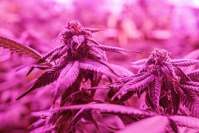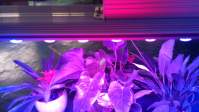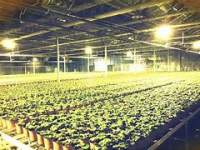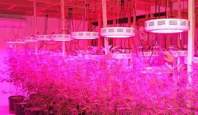Purchasing 1000w LED plant lights is a long-term investment project. Due to the low energy consumption, low heat radiation and spectrum optimized for effective plant growth, it will inevitably be rewarded over time. However, if the arrangement is unreasonable, all these investments may prove to be wasted. Today, Yaorong Technology will teach you 3 ways to ensure the efficient growth of plants through 1000w LED plant lights.
The first step: determine the plant's supplementary light needs
First of all, we determine how to use 1000wLED plant lights to best provide light for plants. So let's take a look at what issues need to be paid attention to?
For the daily photoperiod of plants, we need to know how long it takes for plants to supplement light every day. It is impossible to supplement light 24 hours a day, because plants also need to rest. We can do this:
1. Determined according to the degree of light-loving of the plant
For plants that are more light-loving, you need to use 1000w LED plant lights to supplement the light for the plants at 6:00-10:00 and 17:00-00:00, because 10:00-17:00 is the sunlight to meet their growth needs Time, so it takes about 11 hours for the plants to fill in the light.
For normal light-loving plants, their growth needs can be met when there is sunlight. If not, the time of supplementing light with 1000w LED plant lights only needs to be set according to the local sunrise and sunset time, and the supplementary light time should avoid plant rest as much as possible. Time.
2. Set according to the planting environment
The planting environment mentioned here includes the difference between the north and the south, the difference between spring, summer, autumn and winter, and the difference between indoor and outdoor sunlight. Regional and seasonal differences can be set according to the light law, the closer to the equator, the stronger it is to set the lighting time with 1000wLED plant lights. Or strong in summer and weak in winter, set the lighting time with 1000w LED plant lights according to local conditions. There is a big difference in the light that can be received by indoor and outdoor plants. Indoors need 16-18 hours of full-time supplement light, and outdoor plants need to supplement light according to the difference in sunlight illuminance.
The light intensity, how many photons "supply" the plant, is usually measured in µmol/m 2 /s, and the correct spectrum, that is, the combination of wavelengths, is determined for each growth stage.
What makes this task challenging are the different requirements for each plant species and each growth stage. Good artificial lighting is very close to sunlight, but artificial lighting can go a step further and provide wavelengths for plants. Compared with growing in the sun, plants grow faster and have more nutrients. Regarding how many photons are used to "supply" a plant, we can give an example: a lettuce needs ~80 µmol/m 2 /s in the seedling stage, and needs ~150 µmol/m 2 /s and 200 µmol/m 2 in the vegetative stage. Above/s when it starts to bloom. The understanding of its light intensity requirements comes from multiple experiments in which its behavior is observed under different types of light sources and intensity levels.
The second step: the choice of LED plant light
Knowing how much light the plants need in each growth stage can be used in various aspects such as how many LED plant lights should be used, what type of LED plant lights, and their power. How many LED plant lights to use can be calculated and selected according to your planting area; there are three types of LED plant lights: tube, strip and box lights, which are selected according to the planting space area and the installation method; finally It is the power choice of LED plant light. We suggest that if it is planting in a large area, then choose high-power LED plant light. For example, Yaorong Technology 1000w LED plant light is good. If it is family planting or small area planting, choose small The power LED plant light does not waste cost and is more cost-effective.
The third step: 1000wLED plant light supplement light skills
1. Uniform illumination
The chip distribution is based on the light-filling plant characteristics of the 1000w LED plant light. After the lamp bead ratio is obtained, how to intersect between the chips is calculated, and finally distributed on the plant light package and COB panel according to a certain rule, so that each LED plant The light illuminates the main area with uniform light quality and light intensity distribution.
The arrangement of the spacing between each 1000w LED plant light is calculated according to the planting space area to obtain the distance distribution between each 1000w LED plant light, so as to ensure the uniformity of the large-area planting light.
2. Illumination distance
The illumination distance of 1000wLED plant lights is very important. You need to adjust the points for different plants at different stages, and the distance should be unified to make the illumination more uniform. If the distance is not well controlled, it may harm the growth of plants. The general recommendation is that the germination stage distance: 60 cm, the seedling stage distance: 75 cm, the growth stage distance: 45 cm, and the flowering stage distance: 30 cm.
3. Efficient use of light
The 1000w LED plant light can also achieve efficient use of light under the condition of uniform illumination. The main physical principles used are light reflection and light refraction.
The 1000w LED hemp plant light uses the reflection and refraction of light to not only make the light more uniform, but also achieve high luminous efficiency. It mainly uses the reflector and the metal substrate used by the COB. The principle of the reflector reflects the light emitted by the light source into a beam to increase the local light intensity. , The reflective effect of the metal substrate is also to maximize the light energy emitted by the 1000wLED plant lamp beads to be used by plants, and the reflected part is auxiliary light, which also has the function of fixing the lamp beads and heat dissipation.
The principle of light refraction used by 1000wLED plant lights is mainly to use optical lenses. The principle changes the propagation trajectory of light. Generally, single lenses and retest lenses are used, which can very accurately control the distribution of light.
4. Humidity, temperature
Photosynthesis and transpiration rate are directly affected by temperature, humidity and airflow. Find the best temperature and humidity for your plants between 75*-85*F and 50%-70% humidity, and have sufficient airflow to replenish carbon dioxide.
Nowadays, more and more plants need 1000wLED plant lights to supplement light. 1000wLED plant lights can control the plant's supplementary light growth environment and give plants better growth in all stages. Not only has the output increased, but the harvest time has also been advanced. It can be produced at any time throughout the year. It is no longer affected by environmental seasons, seasons and geographical restrictions. LED plant lights and agriculture will definitely undergo tremendous changes in the future. Let us look forward to it together.






